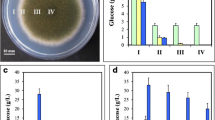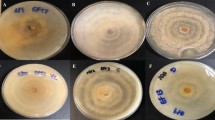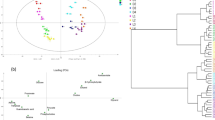Abstract
Ligninolytic activity in the white-rot fungus Phanerochaete chrysosporium was previously found not to be induced by lignin, but to develop in cultures in response to nitrogen starvation. Added NH +4 suppressed existing activity. The present study examined amino acid profiles and protein concentrations during onset of ligninolytic activity (synthetic 14C-lignin→14CO2) in nitrogen-limited cultures, and defined some characteristics of subsequent suppression by added nutrient nitrogen. During the transition between depletion of medium nitrogen and the onset of ligninolytic activity, total free intracellular amino acids increased, then rapidly decreased; changes in glutamate concentration played a major role. Intracellular protein concentration fluctuated in a manner roughly converse to that of the concentration of free amino acids. Protein turnover was rapid (5–7%/h) during the transition period. Glutamate, glutamine, and histidine were the most effective of 14 nitrogenous compounds in suppressing ligninolytic activity after its onset. The suppressive effect was not mediated through carbon (glucose)-catabolite repression or by alterations in culture pH. Activities responsible for oxidation of lignin and the ligninrelated phenol, 4-hydroxy-3-methoxyacetophenone, responded similarly to added nitrogen. Synthesis of a secondary metabolite, veratryl alcohol, like lignin oxidation, was suppressed quite sharply by glutamate and significantly by NH +4 . Results indicate that nitrogen metabolism affects ligninolytic activity as a part of secondary metabolism, and suggest a role for glutamate metabolism in regulating this phase of culture development.
Similar content being viewed by others
Abbreviations
- DMS:
-
2,2-dimethylsuccinate
- GLC:
-
gas-liquid chromatography
- TCA:
-
trichloroacetic acid
References
Arst HN, Jr, Bailey CR (1977) The regulation of carbon metabolism in Aspergillus nidulans. In: JE Smith, JA Pateman (eds) Genetics and physiology of aspergillus. London: Academic Press, pp 131–146
Bradford MM (1976) A rapid and sensitive method for the quantitation of microgram quantities of protein utilizing the principle of proteindye binding. Anal Biochem 72:248–254
Bu'Lock JD (1975) Secondary metabolism in fungi and its relationship to growth and development. In: JE Smith, DR Berry (eds) Filamentous fungi, Vol. 1, Industrial mycology. New York: Wiley, p 33–58
Dantizig AH, Zurowski WK, Ball TM, Nason A (1978) Induction and repression of nitrate reductase in Neurospora crassa. J Bacteriol 133:671–679
Demain AL, Kennel YM, Aharonowitz Y (1979) Carbon catabolite regulation of secondary metabolism. In: AT Bull, DC Ellwood, C Ratledge (eds) Microbial technology: Current State, Future Prospects. Cambridge: Cambridge Univ Press, pp 163–185
Eaton D, Chang H-m, Kirk TK (1980) Fungal decolorization of kraft bleach plant effluents. Tappi 63:103–106
Fenn P, Kirk TK (1979) Ligninolytic system of Phanerochaete chrysosporium: Inhibition by o-phthalate. Arch Microbiol 123:307–309
Fenn P, Choi S, Kirk TK (1981) Ligninolytic activity in Phanerochaete chrysosporium: Physiology of suppression by NH +4 and l-glutamate. Arch Microbiol 130:66–71
Ferguson AR, Sims AP (1974) The regulation of glutamine metabolism in Candida utilis: the role of glutamine in the control of glutamine synthetase. J Gen Microbiol 80:159–171
Gold MH, Cheng TM (1979) Conditions for fruit body formation in the white-rot basidiomycete Phanerochaete chrysosporium. Arch Microbiol 121:37–42
Hynes MJ (1974) Effects of ammonium, l-glutamate, and l-glutamine on nitrogen catabolism in Aspergillus nidulans. J Bacteriol 120:1116–1123
Keyser P, Kirk TK, Zeikus JG (1978) Ligninolytic enzyme system of Phanerochaete chrysosporium: Synthesized in the absence of lignin in response to nitrogen starvation. J Bacteriol 135:790–797
Kirk TK, Connors WJ, Bleam RD, Hackett WF, Zeikus JG (1975) Preparation and microbial decomposition of synthetic [14C]-lignins. Proc Nat Acad Sci USA 72:2515–2519
Kirk TK, Fenn P (1981) Formation and action of the ligninolytic system in basidiomycetes. In: J Hedger, J Frankland (eds) Decomposition by basidiomycetes. Cambridge: Cambridge Univ Press
Kirk TK, Schultz E, Connors WJ, Lorenz LF, Zeikus JG (1978) Influence of culture parameters on ligni metabolism by Phanerochaete chrysosporium. Arch Microbiol 117:277–285
Kirk TK, Yang H-H (1979) Partial fungal delignification of unbleached kraft pulp. Biotechnol Lett 1:347–352
Legerton TL, Weiss RL (1979) Mobilization of sequestered metabolites into degradative reactions by nutritional stress in Neurospora. J Bacteriol 138:909–914
Lundquist K, Kirk TK (1978) De novo synthesis and decomposition of veratryl alcohol by a lignin-degrading basidiomycete. Phytochemistry 17:1676
Mora Y, Espin G, Willms K, Mora J (1978) Nitrogen accumulation in mycelium of Neurospora crassa. J Gen Microbiol 104:241–250
Miller HM, Sullivan PA, Shepard MG (1974) Intracellular protein breakdown in thermophilic and mesophilic fungi. Biochem J 144:209–214
Prival M, Magasanik B (1971) Resistance to catabolite repression of histidase and proline oxidase during nitrogen-limited growth of Klebsiella aerogenes. J Biol Chem 246:6288–6296
Reid ID (1979) The influence of nutrient balance on lignin degradation by the white-rot fungus Phanerochaete chrysosporium. Can J Bot 57:2050–2058
Shimada M, Kirk TK, Nakatsubo F, Higuchi T (1981) Biosynthesis of veratryl alcohol in relation to lignin degradation in Phanerochaete chrysosporium. Arch Microbiol 129:321–324
Trinci APJ, Thurston CF (1976) Transition to the non-growing state in eukaryotic micro-organisms. In: TGR Gray, JR Postgate (eds) The survival of vegetative microbes, 26th Symp Soc Gen Microbiol. Cambridge: Cambridge Univ Press, pp 55–80
van de Poll KW (1973) Ammonium repression in a mutant of Saccharomyces carlsbergensis lacking NADP dependent glutamate dehydrogenase activity. FEBS Lett 32:265–266
Van Pilsum JF, Martin RP, Kito E, Hess J (1956) Determination of creatine, creatinine, arginine, guanidinoacetic acid, guanidine, and methylguanidine in biological fluids. J Biol Chem 222:225–236
Weinstein DA, Krisnangkura K, Mayfield MB, Gold MH (1980) Metabolism of radiolabeled β-guaiacyl ether-linked lignin dimeric compounds by Phanerochaete chrysosporium. Appl Environ Microbiol 39:535–540
Weiss RL (1973) Intracellular localization of ornithine and arginine pools in Neurospora. J Biol Chem 248:5409–5413
Yang H-H, Effland MJ, Kirk TK (1980) Factors influencing fungal degradation of lignin in a representative lignocellulosic, thermomechanical pulp. Biotechnol Bioeng 22:65–77
Author information
Authors and Affiliations
Rights and permissions
About this article
Cite this article
Fenn, P., Kent Kirk, T. Relationship of nitrogen to the onset and suppression of ligninolytic activity and secondary metabolism in Phanerochaete chrysosporium . Arch. Microbiol. 130, 59–65 (1981). https://doi.org/10.1007/BF00527073
Received:
Accepted:
Issue Date:
DOI: https://doi.org/10.1007/BF00527073




